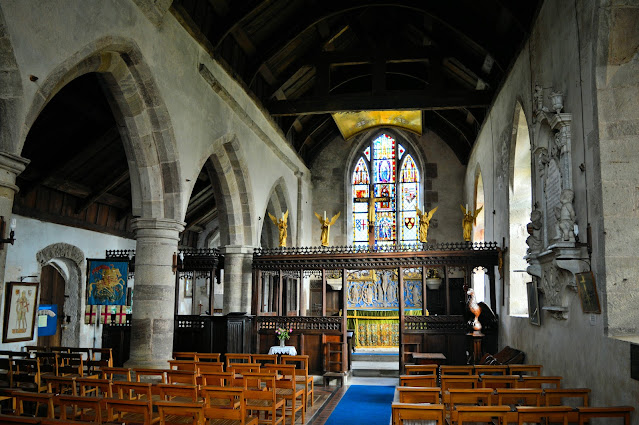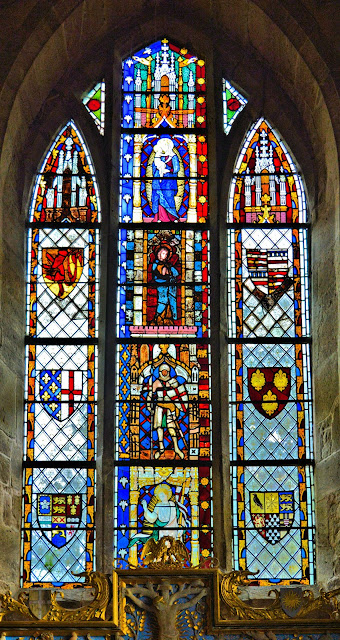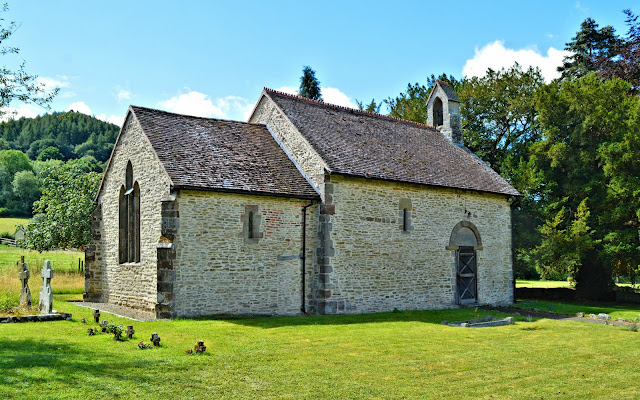St George, Brinsop, Herefordshire
A small church in an idyllic setting and packed with interest. There are important works of the Herefordshire School of Romanesque Sculpture, much fine woodwork, notable glass both ancient and more modern, a Wordsworth connection and exquisite Ninian Comper embellishments of the 1920s. Brinsop Court, a moated 14th century manor house, lies across the fields to the North East. The seat of the Danseys for 500 years until 1817, the house was subsequently leased to Thomas Hutchinson, brother-in-law of William Wordsworth. The poet visited several times between 1827 and 1845 and wrote many letters and some verses there.
 |
| St George, Brinsop. The South side. |
The church was restored gently by local architect William Chick in 1866-7. He added the bellcote, restored the South porch and repaired the roofs. The church appears to date entirely from 1330-40, both inside and out. The interior is dominated by the work of Sir Ninian Comper of the 1920s. He restored the 15th century screens, added the gilded rood figures and the ceilure above the chancel. He restored the glass in the East window and provided five other windows including the West window, a Great War memorial.
Internally, the church has a nave and chancel in one and a lean-to North aisle/North chapel with a four bay arcade between the two. The Eastern bay is separated from the Western three by a screen which extends across the full width of the church. A further screen subdivides the chancel and the North chapel. The screens have medieval origins but were elegantly restored by Comper.
 |
| St George, Brinsop. The interior, looking East. Comper's work to the fore. |
The principal treasures at Brinsop are on the North aisle wall, now protected from the weather but originally external. The former tympanum of the 12th century depicting St George slaying the dragon is one of the foremost works of the Herefordshire School of Romanesque Sculpture. It has brought visitors to Brinsop for more than a century. Additionally, the vestry doorway is surmounted by sculpted wedge-shaped voussoirs, either from the same doorway or a second door. Further 12th century voussoirs are now over the door inside the vestry. There is further sculpture - a square panel depicting birds on the West wall and a fragment of interlace in the North chapel.
.jpg) |
| St George and the Dragon. Legend has it that the event took place in the field to the South of the church |
 |
| Recognisable Herefordshire School motifs above the vestry door. There are more within. |
 |
| Another familiar Herefordshire School emblem - the panel of birds on the West wall |
 |
| A fragment of high quality interlace from the 1140s |
There are a number of monuments to the Dansey family of Brinsop Court, two floriated coffin slabs of the early 14th century and the fading remains of three wall paintings. The plain font dates from the early years of the 13th century and a handsome 15th century stoup with quatrefoils adjoins the South door.  |
| William Dancey of Brinsop Court, died 1708. Memorial tablet by Edward Stanton |
.jpg) |
| The early 15th century stoup |
.jpg) |
The plain tub font, dated by Pevsner to c.1200
Ninian Comper's magnificent chancel, particularly his dazzling alabaster reredos of 1926-7, draws us East as soon as we enter. The reredos is very similar to one he designed for St John the Divine, Stockcross, Berkshire in 1905-7. The existing medieval image brackets have been filled by large gilded figures of St George and St Martin. Above this ensemble is Comper's East window, one of six he provided for this church. The East window contains two exquisite early 14th century panels, a female saint and a triumphant St George.
Ninian Comper's reredos, a version of one he had installed at Stockcross in Berkshire in 1907
The West window of 1920 by Comper is a Great War memorial. Dame Constance Sutton of Brinsop Court lost her son Sir Richard Vincent Sutton MC, a Captain in the 1st Life Guards, in France. He was not killed in action but was taken ill with a high temperature after the Armistice on 2oth November 1918. He died from influenza on 29th November and was buried at Terlincthun British Cemetery in the Pas-de-Calais on 1st December. He was 27 years of age. He had previously sent a letter home saying that it was truly wonderful that he and his half-brother Philip 'should be alive to see peace without even losing a limb'.
The West window, a tribute to all who fought in World War I
The stained glass in the church is exceptional. The Comper windows apart, there are two offerings by Clayton and Bell which more than hold their own. The North West window of the North aisle of 1873 has a small seated Christ figure in the tracery, a survival from the 14th century. A further Clayton and Bell window in the nave dates from 1881. The East window is a fitting climax, a harmonious mix of ancient and modern and one of Sir Ninian Comper's finest.
The magnificent East window
St George, who reputedly slayed the Dragon in the field to the South of the church
The 700 year connection between the church and Brinsop Court, together with a brief explanation of how William Wordsworth came to be associated with both and how he and his family are commemorated, is explored in 'Brinsop Court, the church and the Wordsworths'.
The East end, St George, Brinsop
The West end, St George, Brinsop
|


.jpg)




.jpg)
.jpg)




.jpg)


Comments
Post a Comment